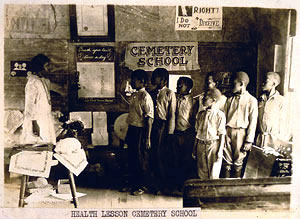
Commonwealth Fund
The Commonwealth Fund has played an important part in the development of public health and medical education in Tennessee since the 1920s. Anna Richardson Harkness created the Commonwealth Fund in 1918 as a philanthropic outlet for the fortune amassed by her late husband, Stephen V. Harkness, one of John D. Rockefeller’s original partners in Standard Oil. Their son Edward S. Harkness, the fund’s first president, and director Barry Conger Smith charted its early course into child welfare and public health issues. The Commonwealth Fund was a major contributor to the child guidance movement from 1922 to 1945. Its experience in public health issues led to the adoption of medical education as the primary philanthropic subject by the late 1940s. In recent decades, the fund has broadened its scope to include social and public policy issues in medicine. It still offers the graduate fellowships to British students in the United States initiated by Edward Harkness in 1925.
Tennessee was one of the Commonwealth Fund’s major laboratories for public health, hospital construction, and medical education programs. Between 1924 and 1928 the fund operated one of its four experimental child health demonstration programs in Rutherford County. The Rutherford demonstration, headed by Dr. Harry S. Mustard, operated children’s and maternity clinics and sponsored health education programs in public schools. Demonstration staff also functioned as Rutherford’s public health department.
The Commonwealth Fund’s success in Rutherford County resulted in Tennessee’s becoming one of its three target states in the 1920s and 1930s. The fund’s Division of Rural Hospitals built the Rutherford Hospital in Murfreesboro (1927) and contributed to the Holston Valley Community Hospital in Kingsport (1935). In the late 1920s and early 1930s its Division of Public Health operated field units in Rutherford, Sumner, Gibson, and Sullivan Counties and provided funds for a mobile field unit to the state health department. The Commonwealth Fund, the University of Tennessee, and the Tennessee Health Department jointly sponsored a state health education program instituted in 1930. Rutherford County also received a health department building as a gift from the Commonwealth Fund in 1931 in recognition of its central role in the fund’s rural health work. Later, the fund granted monies for the construction of public health clinics in both Trenton, Gibson County (1937), and Gallatin, Sumner County (1946).
From 1927 until 1949, the fund offered fellowships to physicians on its hospital staffs for post-graduate study at Commonwealth Fund-sponsored medical schools such as Vanderbilt University. Medical and nursing students at those medical schools came to the Rutherford Hospital for training in rural public health practice. At Vanderbilt the Commonwealth Fund donated undergraduate pre-medical scholarships and fellowships for nursing students and advanced medical study and research. The fund began offering fellowships to African American medical students at Meharry Medical College in 1949. In the late 1960s and early 1970s, the Commonwealth Fund’s grants to Meharry and Vanderbilt included the construction of biomedical sciences and basic sciences buildings at Meharry and expanded medical facilities and a clinical research center at Vanderbilt.
Suggested Reading
Mary S. Hoffschwelle, “Organizing Rural Communities for Change: The Commonwealth Fund Child Health Demonstration in Rutherford County, 1923-1927,” in Tennessee History: The Land, the People, and the Culture, ed. Carroll Van West (1998), 373-91



